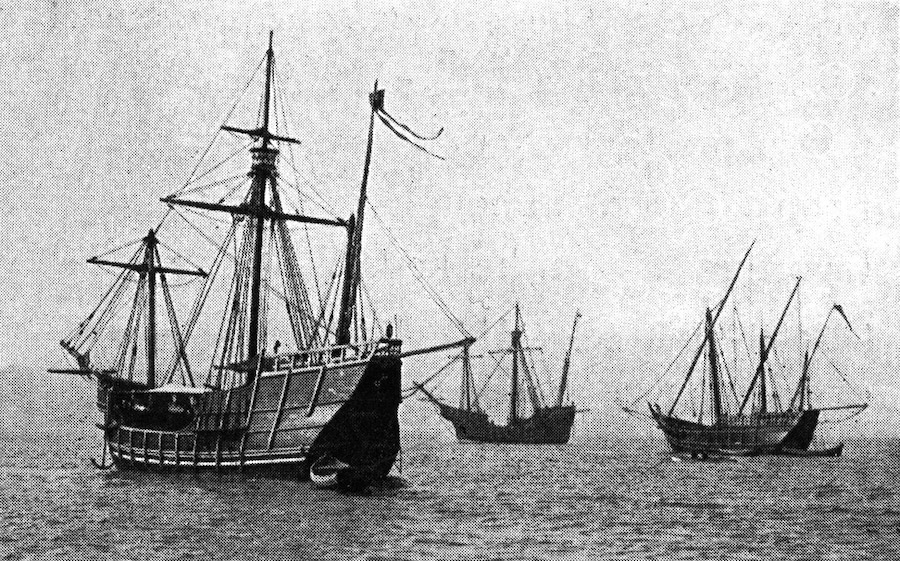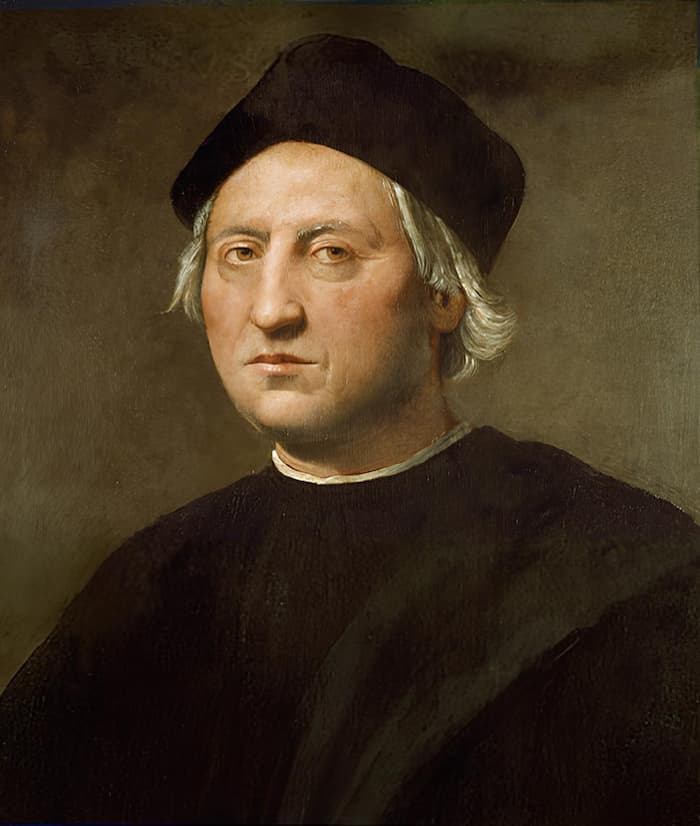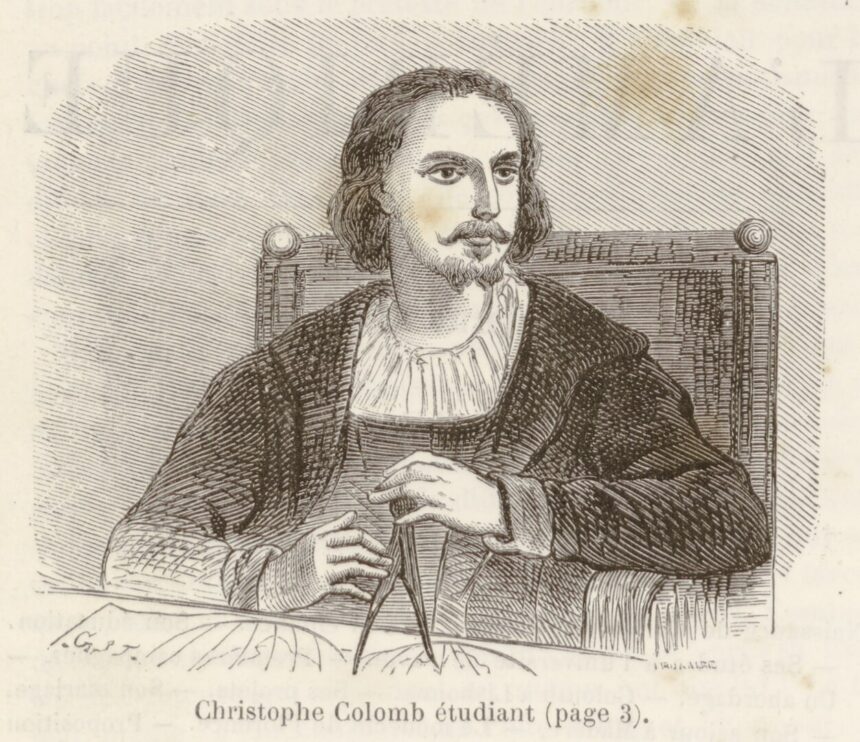Navigator in the service of the Spanish sovereigns, Christopher Columbus was born on January 1, 1451, in Genoa (Italy). He died on May 20, 1506, in Valladolid. Aboard his three ships, he unknowingly sailed toward the New World.
He is known as “the man who discovered America” in 1492. However, other navigators, such as the Icelandic Leif Erikson (son of Erik the Red), had done so centuries before him. Yet, history remembers the name of the Italian navigator. Columbus had a dream: to find a new route to the Indies. Although he unknowingly failed in this quest, his discovery was no less significant.
Birth (and youth) of Christopher Columbus
Cristoforo Colombo, known as Christopher Columbus, was born in Genoa, Italy, in 1451, although doubts still persist about his birthplace. He was the son of a weaver, Domenico Colombo. Rejecting the life of an artisan, Columbus decided early on to become a sailor. The young man studied navigation and sciences. In 1476, he set sail aboard a ship bound for Lisbon and England. Following an attack by the French, Columbus ended up in Lagos and then joined his brother in Portugal. There, he met Filipa Perestrelo e Moniz, the daughter of one of Madeira’s colonizers. He married her in 1479, and they had a son, Diego.
The Origin of Christopher Columbus’ Voyage
Columbus harbored a dream: to discover a new route to the Indies by crossing the Atlantic. Until then, explorers would go around Africa, which was costly. Columbus studied the writings of various scholars. Adhering to the idea that the Earth was round, he believed he could reach Asia by sailing west across the Atlantic. In his mind, Europe wasn’t far from Asia. While Ptolemy estimated the distance to be 16,090 km, Columbus reduced it to 2,414 km.
The explorer presented his project to a committee of experts appointed by King John II of Portugal. The committee rejected it, and the king refused to finance him. Not giving up, Columbus presented his plan to Isabella of Castile in 1486. She refused in 1490 due to his demands: Columbus wanted to be named Admiral of the Ocean and Viceroy of all discovered lands. The following year, he re-pitched his proposal to the Catholic Monarchs of Spain. King Ferdinand’s advisor convinced Queen Isabella by highlighting the financial benefits of the endeavor. She was also swayed by the evangelical goals tied to the expedition.
Ships

To chart a new route to the Indies—a quest he would fail but lead to an even more significant discovery—Columbus set sail from Palos, Andalusia, on August 3, 1492. He commanded three ships and a crew of 90 men. These ships are famous: the Santa María, the Pinta, and the Niña. The Santa María was the largest and the ship Columbus sailed on. The Pinta was the fastest, and the Niña was the smallest, as its name suggests. After a stop in the Canary Islands, the expedition embarked on a two-month-long voyage. Worried, the crew almost mutinied.
Columbus and America
On October 10, 1492, land was finally sighted. The ships landed on October 12 on the island of Guanahami, in the present-day Bahamas. Columbus claimed it in the name of the Spanish Catholic Monarchs and named it San Salvador. The navigator believed he had reached the Indies, which is why he called the indigenous people “Indians.” The locals informed him of the presence of gold in Cuba. He arrived on the island on October 28 and declared it Spanish territory.
The captain of the Pinta deserted to search for gold further west. In December, the Santa María wrecked, and Columbus found himself on the island of Hispaniola (now Haiti), where he found gold and left about 40 men in a fort. Columbus returned to Spain aboard the Niña and reunited with the Pinta on the way back. Upon his return to Europe, the success of the expedition increased the Admiral’s ambition, and he was already preparing for another voyage.
As for the name “America,” it comes from the Florentine Amerigo Vespucci. His name was used by a printer from the Vosges in 1507 when he wanted to reprint Ptolemy’s Cosmographia, the geographic reference of that time. The printer wanted to include the newly discovered lands and called upon the geographer Martin Waldseemüller to map them. Waldseemüller recalled Vespucci’s work Mundus Novus from 1503, which mentioned new lands. He named these lands “America” in honor of the navigator. Vespucci had made several voyages to America, though the exact number and dates are uncertain. He did not precede Columbus but played a part in organizing Columbus’s second voyage, and the two became friends. Though he was not the first to land on the continent, Vespucci was the first to recognize that they had discovered a new continent.
Christopher Columbus and 1492
1492… a date that resonates as a major historical event: Christopher Columbus discovers America! Ironically, he was convinced he had reached the Indies and was completely satisfied with having achieved his goal. He would never know that he had discovered a new continent and that his discovery would earn him a place in the annals of geography. To everyone, Christopher Columbus is the one who discovered America. In reality, other navigators, such as the Icelander Leif Eriksson (the son of Erik the Red), had done so several centuries before him. But history has retained the name of the Italian navigator.
Christopher Columbus and His Other Voyages

In September 1493, once again mandated by Queen Isabella I of Spain, Christopher Columbus set sail with a fleet of 17 ships and 1,500 men with the goal of establishing a colony. The Admiral discovered the Lesser Antilles (Guadeloupe and Dominica) and Puerto Rico. He explored the coasts of Cuba and Jamaica. He found the garrison in Hispaniola, which he had established during his first voyage, decimated by syphilis (or by the Indigenous peoples). Columbus settled farther away and founded the colony of Isabela, entrusting its governance to his brother, Bartolomeo Columbus. He discovered that the indigenous people of these islands practiced cannibalism, using this as a pretext to enslave them. He returned to Spain in 1496.
Shortened Third Voyage
Christopher Columbus set sail again for the “Indies” in 1498. Five of the eight ships were redirected to Hispaniola to supply it. The Admiral continued his expedition toward the island of Trinidad. Ferdinand and Isabella of Spain received complaints about the mismanagement of the colony. They sent Francisco de Bobadilla (a Spanish colonial administrator) to arrest Columbus and his brother. Bobadilla brought them back to Spain for trial.
Eventful Fourth Voyage
After the trial, Christopher Columbus was stripped of control over his new lands. However, he was allowed to embark on his fourth voyage in 1502. He reached the coasts of present-day Honduras and discovered an abundance of gold in Panama. However, he had to confront the Indigenous people and lost four of his ships. He took refuge on the island of Jamaica. Eventually, he was rescued and decided to return to Spain in 1504. The great navigator passed away in Valladolid on May 20, 1506, still believing he had reached the Indies but deprived of all his privileges.
Christopher Columbus’ Logbook
The explorer’s voyages are compiled in his logbook titled “Logbook (1492-1493),” in which he described the stages of his journeys. These daily notes were later transcribed and abridged by the Dominican priest and Spanish missionary Bartolomé de las Casas (1485-1566), who was also a writer and historian and a defender of the rights of the Indigenous people against the practices of the Spanish colonists. The original logbook of Christopher Columbus had been given by the navigator himself to the Spanish sovereigns (the Catholic Monarchs) upon his return from the expedition but was later lost.
Christopher Columbus: Key Dates

January 1, 1451: Birth of Christopher Columbus
Cristoforo Colombo, also known as Christopher Columbus, was born in Genoa, Italy. The son of a weaver, he chose a life at sea early on.
1479: Married
Christopher Columbus married Filipa Perestrelo e Moniz, the daughter of one of the colonizers of Madeira. She bore him a son and died shortly after.
1480: He nurtures great ambition
Columbus studied sciences, navigation, cartography, and cosmography. He began to imagine reaching the Indies by crossing the Atlantic Ocean. His next challenge was convincing the Spanish or Portuguese monarchs to support his project, a task that proved difficult.
1484: Columbus tries to convince the King of Portugal
Christopher Columbus presented his project to a commission of specialists appointed by King John II of Portugal. After the commission’s negative recommendation, the king declined.
1486: Christopher Columbus turns to the Catholic Monarchs of Spain
Columbus met the Catholic Monarchs and presented his project. A scientific commission was assembled to evaluate the expedition. In 1487, following the commission’s recommendation, the Catholic Monarchs gave him a negative response. Columbus did not give up and would try to convince them again a few years later.
April 17, 1492: The Capitulations of Santa Fe
The Catholic Monarchs of Spain, convinced by Columbus’s arguments, agreed to finance his project to cross the Atlantic. They signed the Capitulations of Santa Fe (named after the camp near Granada), which allowed Columbus to outfit ships and gave him the title of Viceroy of the lands to be discovered. The generosity of the monarchs can be attributed to their euphoria following their victory over Granada, ending Muslim presence in the Iberian Peninsula. Columbus would return triumphantly to Seville on March 31, 1493, believing he had discovered the Indies by sailing west.
August 3, 1492: Christopher Columbus leaves Spain
The Genoese navigator Christopher Columbus departed from the port of Palos (Andalusia), hoping to reach the East Indies and their spices by sailing west. Portugal, having discovered the route to the Indies via the Cape of Good Hope, had rejected his plan. But the Catholic Monarchs of Spain, eager to evangelize the world, agreed to finance his voyage.
Three caravels—the Santa María, the Pinta, and the Niña—left Spain, sailing westward. Two months later, they would arrive in the Caribbean, believing they had reached the Indies.
October 28, 1492: Columbus discovers Cuba
A few days after setting foot on the first Caribbean islands (October 12), Christopher Columbus encountered the large island of Cuba. He claimed it for Spain and named it “Juana” in honor of the son of the Catholic Monarchs: Prince Juan.
September 25, 1493: Columbus embarks on his second voyage to the New World
The Genoese navigator began his second voyage to what he still believed were the Indies. Mandated once again by Queen Isabella of Spain, he led a fleet of 17 ships. During this expedition, he discovered the Lesser Antilles (Guadeloupe and Dominica) and Puerto Rico. He explored the coasts of Cuba and Jamaica. In Haiti, he found the garrison he had established during his first visit had been decimated by syphilis. He discovered that the indigenous peoples of these islands were cannibals and enslaved them under this pretext. Columbus did not find the riches and gold he sought and returned to Spain in 1496.
May 3, 1494: Christopher Columbus lands in Jamaica
Columbus’s fleet discovered the island of Jamaica, then called Xaymaca by the indigenous Arawak people, the first inhabitants of the island. The Spanish would establish a colony, massacre the indigenous people, and import African slaves to work on tobacco and sugar plantations. The English seized the island in 1655, and Jamaica gained independence within the Commonwealth in 1962.
1498: A shortened third voyage
The Admiral set sail again with eight ships for a third voyage. On July 31, five ships were redirected to the Hispaniola colony to supply it with basic goods. Columbus himself reached the island of Trinidad. The Catholic Monarchs of Spain, having received complaints about Columbus’s poor governance of the colony, sent Bobadilla to arrest Columbus and his brothers and bring them back to Spain. Following his trial, the great navigator lost all his privileges.
1502: Fourth and final voyage
Columbus was granted permission to depart again in 1502. He landed on the coasts of Honduras, where he found gold but faced hostility from the indigenous people. He lost four ships and requested help from the Hispaniola colony. The colonists eventually intervened, finding Columbus in poor condition. He returned to Spain for good in 1504.
May 20, 1506: Death of Christopher Columbus
The great navigator died in Valladolid, Spain, still believing he had reached the Indies but stripped of all his privileges.


